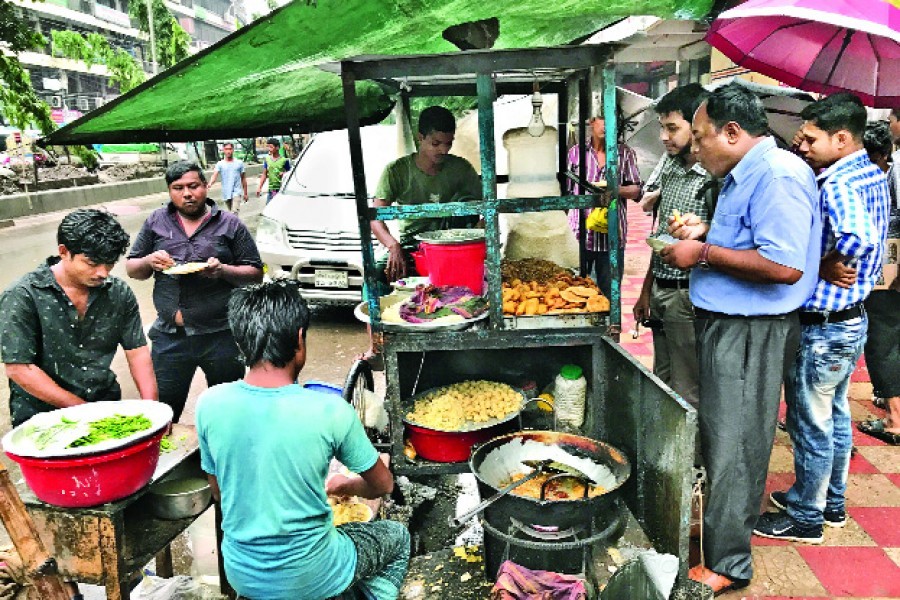Kerina Tull, of the University of Leeds Nuffield Centre for International Health and Development, deals with changing food system in a regime of rapid urbanization. It is a part of very recent research (2018) -- a series produced by a programme called Knowledge, evidence and learning for development (K4D) commissioned by the UK Department for International Development (DFID).
Rapid urbanisation, resulting in rural to urban migration is a reality all over the world. Even in Bangladesh, urbanisation and migration are running very fast. One-third of the city population is reported to live in slums. While there are an avalanche of studies on migration, urbanisation and their impacts on well-being, there seems to be a dearth of literature on the linkage between urbanisation and food system. Kerina Tull's pioneering paper adds to the stock of our knowledge and we can present them, at times paraphrased, to gather knowledge.
The author goes to kick off the discussion with a note that urbanisation is an important factor in changing eating patterns and nutrition trends and the following are the ways:
Rural to urban migrants tend to shift away from staples like rice or wheat and tilt towards sugary and more conveniently consume purchased foods. "Increased eating outside the home (e.g. street food), is found to be a risk factor for higher fat intake and lower-micronutrient levels. (b) The increase of women in city employment has affected the types of food consumed for men, women and children. (c) "A positive aspect of urban food systems is the diversity of food available within most cities. However, diverse high dense diets, which are different from the traditional diet, together with changing physical activity levels, will later lead to greater occurrences of Non-Communicable Diseases (NCDs) such as obesity and diabetes."(c) With increasing urbanisation and sedentary lifestyles in other regions, obesity is now accelerating as a primary health issue in India, China and other fast-shifting nations across Asia and Africa. In Kenya, Senegal and Ghana urban obesity is twice the level found in rural areas. (d) "Urban consumers are increasingly unaware of the processes by which their food is produced and processed. This points to the loss of 'protective factors' in the shift away from more traditional diets, pointing to loss of nutrients and dietary diversity."
Kerina Tull then draws our attention to the changing markets through which foods are channelled. According to the author, urbanisation also changes dramatically the structures of urban food markets leading to a host of interrelated problems such as:
Expansion of super markets increased their market share and due to that they have increased significant power in the supply chain and changing relations in the food value chain impacting on food production (e.g. securing large volumes, operating internationally, market out local small middlemen and processors, negotiating lower prices). (b) "'Food deserts', areas in cities where people have no access to any food at all, are still a reality. Where food is available the quality of the food is often not good, or there are no healthy and nutritious options accessible in the market." (c) "The informal food sector continues to be very important, with vendors purchasing wholesale, or sometimes direct from farmers. It is a critical source of food (including processed and cooked food) and income in urban areas. The informal sector can be a problem because most of the time the quality and safety of food is not good. Food safety training for street food vendors has been shown to improve food safety and quality (e.g. Abidjan, Cote d'Ivoire)."
Therefore, argues the researcher, continued urbanisation in the current form incorporates many risks: increased risks related to poor health and undernutrition; "distancing" of food production via long-distance modern supply chains risks the growing issue of urban food waste; urban poor are especially hard hit by food price inflation and volatility, while price controls on primary products do not guarantee the stability of food prices. "Inequalities in access to food not only risks instability, food riots, and an increase in violence in cities, but also reduces the economic opportunities of poor slum dwellers to increase their micro or small scale food businesses, risking unemployment. Increasing food demands of cities also create intense competition for land, as development encroaches on peri-urban agricultural land: substantial land use and land cover has occurred."
Rapid urbanisation means, as the researcher reckons, greater waste, and greater environmental issues: waste management is directly related to the economic, social and political status of the country. Separate collection of food waste makes treatment much more efficient: Lusaka in Zambia and Cajica in Colombia both have successful food waste programmes. However, few cities are treating food waste, and prevention policies are yet to become mainstream. Other (technological) solutions are to use sewage water from cities for vegetables and fodder crops in peri-urban areas. The Cambio Verde (or Green Exchange programme) in Brazil, allows citizens to trade recyclable materials for fresh peri-urban and rural metropolitan produce originating from family farms, or the option to buy such produce at 30 per cent cheaper than in stores .
The observations in the paper seem to be quite relevant for Bangladesh where 'unplanned urbanisation" and rapid rural-urbanisation are taking place. The food market system has been changing fast with the advent of super markets even in district towns. On-line food shopping is increasing. Especially, unplanned urbanisation is a curse and urbanisation as a whole is not an unmixed blessing as far as food system is concerned. So, sufficient research on this issue is called for.
Abdul Bayes is a former Professor of Economics at Jahangirnagar University


